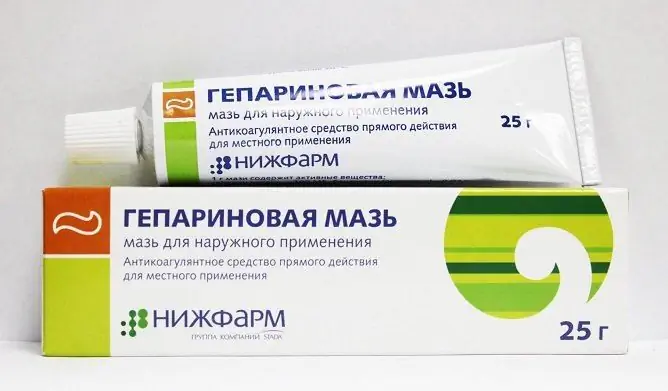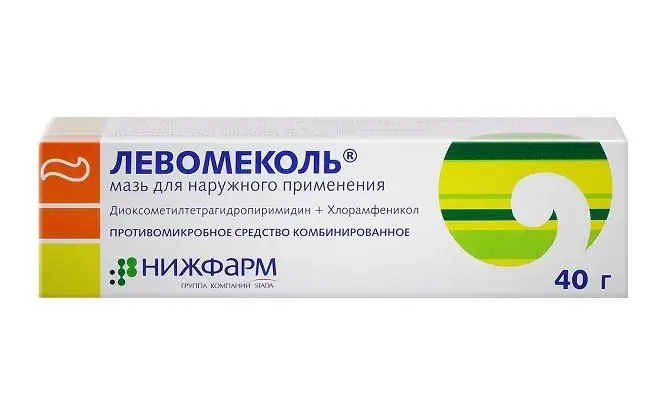- Author Rachel Wainwright [email protected].
- Public 2023-12-15 07:39.
- Last modified 2025-11-02 20:14.
Supirocin-B
Supirocin-B: instructions for use and reviews
- 1. Release form and composition
- 2. Pharmacological properties
- 3. Indications for use
- 4. Contraindications
- 5. Method of application and dosage
- 6. Side effects
- 7. Overdose
- 8. Special instructions
- 9. Application during pregnancy and lactation
- 10. Use in childhood
- 11. In case of impaired renal function
- 12. Use in the elderly
- 13. Drug interactions
- 14. Analogs
- 15. Terms and conditions of storage
- 16. Terms of dispensing from pharmacies
- 17. Reviews
- 18. Price in pharmacies
Latin name: Supirocin-B
ATX code: D07CC01; D06AX09
Active ingredient: betamethasone (Betamethasone) + mupirocin (Mupirocin)
Manufacturer: Glenmark Pharmaceuticals, Ltd. (Glenmark Pharmaceuticals, Ltd.) (India)
Description and photo update: 2020-17-01
Prices in pharmacies: from 427 rubles.
Buy

Supirocin-B is a combined agent for external use, which includes an antibiotic and a glucocorticosteroid (GCS).
Release form and composition
Dosage form - an ointment for external use: a homogeneous mass of white (5 or 15 g in an aluminum tube, in a cardboard box 1 tube and instructions for the use of Supirocin-B).
100 g of ointment contains:
- active ingredients: betamethasone dipropionate, in terms of betamethasone - 0.05 g; mupirocin - 2 g;
- additional substances: macrogol-4000 (polyethylene glycol-4000), macrogol-400 (polyethylene glycol-400).
Pharmacological properties
Pharmacodynamics
Supirocin-B is a combined drug for external use, the effect of which is due to the properties of its active ingredients.
Mupirocin
Mupirocin is an antibiotic produced by the gram-negative bacteria Pseudomonas fluorescens. It inhibits protein production in a bacterial cell by specific reversible binding to isoleucyl-transport RNA synthetase. Thus, preventing the participation of isoleucine in the construction of protein chains. At minimum inhibitory concentrations (MIC), the substance exhibits bacteriostatic properties when used topically, and bactericidal at higher concentrations.
As a result of its specific mechanism of action and its unique chemical structure, mupirocin does not show cross-resistance to other antimicrobial drugs. When used in accordance with the recommended dosage regimen, the threat of the development of refractory bacterial strains is low.
In vivo, mupirocin is active against Staphylococcus aureus (including strains resistant to methicillin), S. Epidermidis, as well as beta-hemolytic strains of Staphylococcus species.
In vitro, the spectrum of drug activity includes the following microorganisms:
- sensitive species: Staphylococcus epidermidis 1,2; Staphylococcus aureus 1.2; Staphylococcus species¹; coagulase-negative (coagulase-negative) staphylococci 1,2; Haemophilus influenzae; Neisseria meningitidis; Neisseria gonorrhoeae; Pasteurella multocida; Moraxella catarrhalis;
- resistant species: anaerobes; Corynebacterium species; non-fermenting gram-negative sticks; Enterobacteriaceae; Micrococcus species.
¹ - Clinical efficacy noted for isolators of susceptible bacteria for clinical indications for use.
² - including methicillin-resistant strains and strains producing beta-lactamase.
Borderline concentrations of susceptibility to mupirocin (MIC) for Staphylococcus spp.: sensitive - ≤1 μg / ml; intermediate sensitivity - 2-256 μg / ml; resistant -> 256 μg / ml.
Betamethasone
Betamethasone is a glucocorticoid that, when applied externally, exhibits antiallergic, antiexudative, local anti-inflammatory and antiproliferative effect. It demonstrates a stronger vasoconstrictor effect compared to other fluorine derivatives of GCS.
Due to the limited absorption through the skin, its systemic effect is insignificant. As a result of application to the skin, the drug prevents the marginal accumulation of neutrophils, which ensures a decrease in exudation and the production of cytokines, inhibition of the migration of macrophages, and ultimately helps to reduce the intensity of infiltration and granulation processes.
Pharmacokinetics
Mupirocin hardly passes through intact skin. When adsorbed through damaged skin, during further biotransformation, it is converted to monic acid (a microbiologically inactive metabolite) and is rapidly excreted by the kidneys.
Betamethasone dipropionate belongs to lipophilic substances and is easily adsorbed through the stratum corneum of the skin, does not undergo biotransformation. Its absorption increases when treating the skin in the area of body folds, skin with damaged epidermis or when applied to areas of inflammation, large areas, or in case of frequent use. Percutaneous absorption in children is faster than in adults.
Indications for use
Supirocin-B is recommended for the treatment of the following diseases complicated by secondary bacterial infections:
- hives;
- contact dermatitis (simple and allergic);
- atopic dermatitis;
- diffuse neurodermatitis;
- exfoliative dermatitis;
- dermatitis herpetiformis;
- seborrheic dermatitis;
- eczema, psoriasis.
Contraindications
Absolute:
- acne vulgaris, rosacea;
- post-vaccination skin reactions;
- bacterial, viral, fungal skin diseases;
- trophic leg ulcers caused by varicose veins;
- cutaneous manifestations of syphilis;
- lupus;
- nevus, atheroma, skin cancer, hemangioma, melanoma, xanthoma, sarcoma;
- age up to 12 years;
- pregnancy and lactation;
- hypersensitivity to any component of Supirocin-B ointment.
Relative (use the ointment with caution):
- moderate to severe renal impairment;
- diabetes mellitus, cataracts, glaucoma, tuberculosis (not recommended for long-term use on large areas of the skin);
- atrophy of the subcutaneous tissue, especially in elderly patients.
Supirocin-B, instructions for use: method and dosage
Supirocin-B ointment is used externally.
Recommended dosage regimen: the ointment is applied to the affected skin area in a thin layer 2-3 times a day for 5-14 days.
Supirocin-B should only be used to treat problem areas no longer than 10 cm or an area of no more than 100 cm².
In the case when no clinical reaction is observed within 3-5 days, a second examination is required.
Side effects
During treatment with Supirocin-B, the following undesirable effects may occur: dry skin, irritation, itching, burning, hypopigmentation, acne-like eruptions, folliculitis, hypertrichosis, perioral dermatitis, prickly heat, skin maceration, allergic contact dermatitis, skin atrophy, secondary infection, allergic reactions including urticaria, angioedema, generalized rash, anaphylaxis.
Overdose
Symptoms of an overdose of Supirocin-B are reactions characteristic of systemic GCS intoxication: glucosuria, hyperglycemia, Cushing's syndrome, reversible suppression of the function of the hypothalamic-pituitary-adrenal system.
Treatment for this condition is prescribed symptomatic.
special instructions
Since macrogol (polyethylene glycol) is able to be absorbed through the wound surface or other skin lesions and excreted by the kidneys, large surfaces should not be treated with ointments based on it against the background of conditions leading to increased absorption of macrogol, especially in the presence of moderate to severe renal failure.
Long-term treatment with the drug can provoke an overgrowth of microbes that are immune to its influence, as well as fungi.
Since the composition of the Supirocin-B ointment includes a potent GCS, it must be used in the acute period of the disease, for a short time and on a small area of the skin surface.
The drug should not be applied under an occlusive dressing, as this can cause epidermal atrophy, the appearance of stretch marks and the occurrence of superinfection.
You can not treat the skin of the face with ointment due to the risk of developing telangiectasias and perioral dermatitis.
You should beware of getting the product on mucous membranes, especially on the mucous membranes of the eyes, as well as on burns and open wounds.
Apply Supirocin-B on the skin in the groin and axillary region only when absolutely necessary.
During antibiotic therapy, cases of the development of a severe side effect - pseudomembranous colitis, from mild to life-threatening severity were recorded. Therefore, it is important to consider the possibility of this diagnosis when diarrhea develops during antibiotic treatment or after its completion. Although the risk of this complication with external use of mupirocin is negligible, in case of abdominal cramps or severe / prolonged diarrhea, the use of the ointment should be stopped immediately and an appropriate examination carried out.
Supirocin-B is prohibited for use in ophthalmology, in combination with the use of catheters, or intranasally.
Influence on the ability to drive vehicles and complex mechanisms
The effect of Supirocin-B on the ability to drive a car and control complex equipment has not been studied.
Application during pregnancy and lactation
The use of the drug is contraindicated for pregnant and lactating women.
Pediatric use
Children under 12 years of age are not prescribed Supirocin-B treatment.
With impaired renal function
Supirocin-B should not be used on large surfaces in patients with moderate to severe renal impairment.
Use in the elderly
Elderly people with atrophy of the subcutaneous tissue should be treated with the drug with extreme caution.
Drug interactions
The interaction of Supirocin-B with other drugs has not been studied.
Analogs
Analogues of Supirocin-B are Bonderm, Supirocin, Bactroban, Gentamicin-AKOS, Levomekol, Levomycetin, Sintomycin, Tetracycline, Erythromycin, etc.
Terms and conditions of storage
Store out of the reach of children at a temperature not exceeding 25 ° C. Do not freeze.
Shelf life is 2 years.
Terms of dispensing from pharmacies
Dispensed by prescription.
Reviews of Supirocin-B
The combined preparation has proven itself well in the treatment of skin diseases complicated by secondary infections, the causative agents of which are sensitive to mupirocin. Therefore, patients leave mostly positive reviews about Supirocin-B. The ointment effectively reduces exudation in the focus of inflammation, reduces infiltration, relieves inflammation and eliminates edema.
The disadvantages of the drug are most often attributed to its high cost.
Price for Supirocin-B in pharmacies
The price of Supirocin-B in the form of an ointment for external use can be 580-720 rubles. per tube, volume 15 g.
Supirocin-B: prices in online pharmacies
|
Drug name Price Pharmacy |
|
Supirocin-B ointment for external use 15 g 1 pc. 427 r Buy |
|
Supirocin-B ointment 2% 15g 778 RUB Buy |

Anna Kozlova Medical journalist About the author
Education: Rostov State Medical University, specialty "General Medicine".
Information about the drug is generalized, provided for informational purposes only and does not replace the official instructions. Self-medication is hazardous to health!






